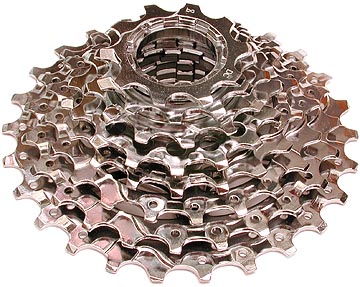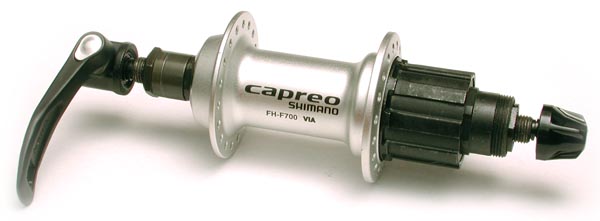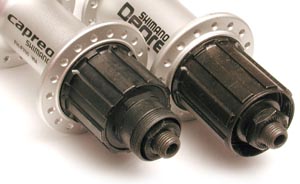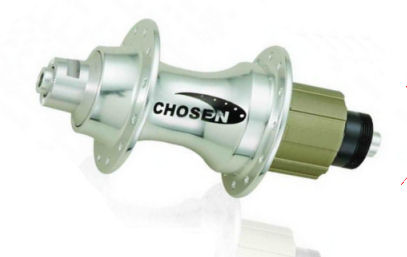The Shimano Capreo hub and Cassette (original) (raw)
The Shimano Capreo System
and its Chosen Successor
| | |  | |
| | ![]() |
| - | --------------------------------------------------------------------------------------------------------------------------------------------------------------------------- | | ------------------------------------------------- |
|
| - | --------------------------------------------------------------------------------------------------------------------------------------------------------------------------- | | ------------------------------------------------- |


High Gears With Small wheels
Small wheels for bicycles have real value for certain applications. Chief among these are folding bikes and "compact" recumbents. Reducing the size of the wheels allows the overall size of a bike to be reduced, and, in the case of many recumbent designs, allows the seat to be placed lower.
As tires improve, the increased rolling resistance of smaller tires becomes less of a concern than it formerly was, but one problem that has persisted is the difficulty of getting decent high gears with a small drive wheel.
The gearing of a normal sprocket-driven wheel is proportional to the wheel diameter, so if you use smaller wheels with the same-sized sprockets, all of your gears will be lower.
Lower lows are rarely a problem, and by using a tight "racing style" cluster in back, you can raise the low gears easily enough if you don't want super low gearing.
The top end, however, has always been a problem with small wheels. There are only three ways to get a decent high gear with small wheels:
Bigger Chainrings
If you have 406 mm (20") wheels, you would need to install a 69 tooth chainring to be equivalent to a 52 tooth with common 622 mm wheels.
If you have 349 mm (16") wheels, you would need to install an 86 tooth chainring to be equivalent to a 52 tooth with common 622 mm wheels!
Even if you could find such a big chainring at an affordable price, you could never find a front derailer that would do a decent job of shifting it.
Internal Gears
An internal gear system, built into either the rear hub or the bottom bracket, can be used alone, or to supplement the derailer gearing, and give a decent high gear. Internal-gearing systems are expensive, heavy and lose efficiency to friction, so they're not universally popular. They do eliminate the need for one or both derailers and multiple sprockets, they shift even when the bicycle is stopped, and they are more reliable and weatherproof than derailer gearing. For this reason, they are popular on bicycles used for urban transportation. See our information on internal gears and about use of an internal hub with derailer gearing for a wider range and more versatility.
Smaller Rear Sprockets
This is potentially the simplest and least expensive way to go, but until recently this was not an option. The smallest sprockets generally available have been 11 teeth, not enough to give a serious high gear with normal-sized chainrings. Some very wide-range "1x" systems (with only a single chainwheel) have a 10-tooth small sprocket, but the largest sprocket has anywhere from 40 to 50 teeth, and the rear derailer may come uncomfortably close to the ground.
Special, very expensive freewheels with 9-tooth sprockets have been available for Moulton bikes, but Moulton has been reluctant to market them to owners of other brands of bikes.
Enter the Shimano Capreo system! This is Shimano's first group intended specifically for small-wheel bikes. The Capreo system includes:
- FH-700 Freehub.
Special 9-speed Freehub, 135 mm spacing, 24, 32 or 36 holes. - CS-HG70-s Cassette
9-10-11-13-15-17-20-23-26 tooth sprockets. - RD-700 Rear derailer.
There are other items included in the Capreo "group" including brakes, rear derailer, crank, shifter, but there is nothing all that special about those. Even the Capreo rear derailer is not necessary to the system, but the Capreo cassette and Capreo Freehub must be used together.
The Capreo is no longer made, but a Taiwanese company, Chosen, is now making a disk-brake hub which takes the same sprockets -- same 135mm axle length as the Capreo and so, a 100% compatible replacement -- you don't have to install the disk. Chosen also makes a hub without the disk-brake fitting and an overlocknut distance of 130mm. The Capreo cassette won't fit any other hubs.


The 5 largest sprockets of the Capreo cassette are standard Shimano cassette sprockets: 15, 17, 20, 23 and 26 teeth. They are individual sprockets, not linked by a spider, but the 4 largest (17-26) are held together by rivets. There is, however nothing preventing an adventurous user from grinding off the heads of the rivets and customizing the bottom end of the gearing.
The 4 smallest sprockets, 9, 10, 11 and 13 teeth are all special.
- The 13 tooth sprocket engages the main splines of the Freehub, but the outside of it is recessed to allow the special 11 to reach the splines. This particular 13 is also used on a couple of other 9-speed models.

- The 11 tooth has external splines that engage the Capreo Freehub body, and internal splines on the outside to engage the 10.

- The 10 tooth has external splines that engage the special 11, and internal splines on the outside to engage the 9.

- The 9 tooth has external splines that engage the special 10 and there is a very small internal-threaded lockring that holds everything together.



The Capreo/Chosen Freehub

The Capreo Freehub has a special body designed to accommodate the smaller diameter of the 9 and 10 tooth sprockets. Otherwise, it appears pretty much similar to other Shimano Freehubs.
Instead of using the esternal-threaded lockring common to other Hyperglide cassettes, the Capreo uses a much smaller inernal-threaded lockring with the same 22 x 1 mm thread as most square-taper cranks.
The Capreo comes set up for 135 mm spacing, but the left side of the axle has two removable spacing washers, one of which is 4 mm and the other 8 mm thick. By removing spacers and trimming the axle, this hub could easily be adapted to other spacings, though this would result in a wheel with more dish.


The Chosen A5217B-FN-130 hub has sealed bearings and 130mm spacing. The spacing is not changeable. The disk-brake version, A4217B-FN-135, however, has 135mm spacing and can be used without a disk brake as a direct replacement for the Capreo hub. The threading of the lockring may be different. Thanks to Sam at Bike Friday for information about this hub. Bike Friday can sell these hubs individually.



Articles by Sheldon Brown and Others
- What's New
- Beginners
- Bicycle Glossary
- Brakes
- Commuting
- Cyclecomputers
- Do-It-Yourself
- Essays and Fiction
- Family Cycling
- Fixed-Gear
- Frames
- Gears and Drivetrains
- Humor
- Old Bikes
- Repair Tips
- Singlespeed
- Tandems
- Touring
- Video
- Wheels
- Translations
- Sheldon - the man
Copyright © 1998, 2008 Sheldon Brown
Harris Cyclery Home Page
If you would like to make a link or bookmark to this page, the URL is:
http://www.sheldonbrown.com/capreo.html
Last Updated: by Harriet Fell
